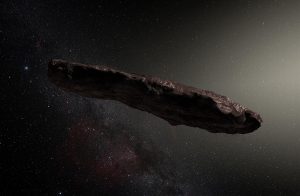
“We’ve never seen anything like this before.” That’s how University of Hawaii astronomer Rob Weryk described the unknown object hurtling through our solar system.1 An object a quarter of a mile long and moving startlingly fast – faster than any comet or asteroid seen before, about 55 miles per second. An object with an open-ended trajectory – meaning that it came from somewhere outside our solar system. The first such object ever observed.
Scientists named the mysterious visitor ‘Oumuamua, meaning “a messenger from afar arriving first” in Hawaiian.2 Intriguing not only due to its origin but also its properties – besides its unusual size, shape, and trajectory, the object has no comet tail and shows no trace of water ice, suggesting that it may be composed entirely of solid rock or even metal – astronomers are turning additional eyes on ‘Oumuamua to test some unsettling hypotheses. After all, given the characteristics of this unusual visitor, who can’t but wonder: is it more than just an asteroid? While likely formed by natural processes, astronomers are thus far at a loss as to what could produce the object’s unusual shape. Is it possible, however distantly, that ‘Oumuamua might be some sort of artifact? According to Harvard University astronomer Avi Loeb, ‘Oumuamua has the optimal design… of a vessel meant to travel through space.3
That’s a proposition that a research initiative called Breakthrough Listen hopes to test. Breakthrough Listen, per their website, is a “$100 million program of astronomical observations in search of evidence of intelligent life beyond Earth” and “by far the most comprehensive, intensive and sensitive search ever undertaken for artificial radio and optical signals.” From NPR:
“The possibility that this object is, in fact, an artificial object — that it is a spaceship, essentially — is a remote possibility,” Andrew Siemion, a member of the initiative and director of Berkeley’s Search for Extraterrestrial Intelligence Research Center, told The Washington Post on Monday.
[…T]hey’ll be checking on that hypothesis by scanning the object for possible artificial transmitters through a radio telescope at West Virginia’s Green Bank Observatory.
As unlikely as this possibility may be, it certainly seems worth looking into. Before our extrasolar visitor leaves our system just as quickly as it entered, bound for distant reaches that for now we can only dream of.
